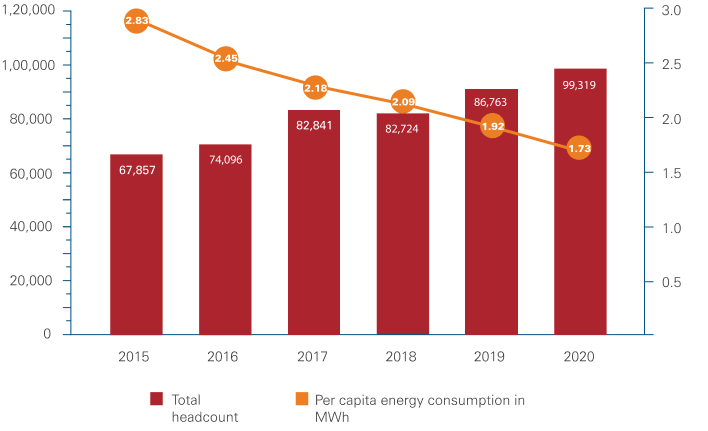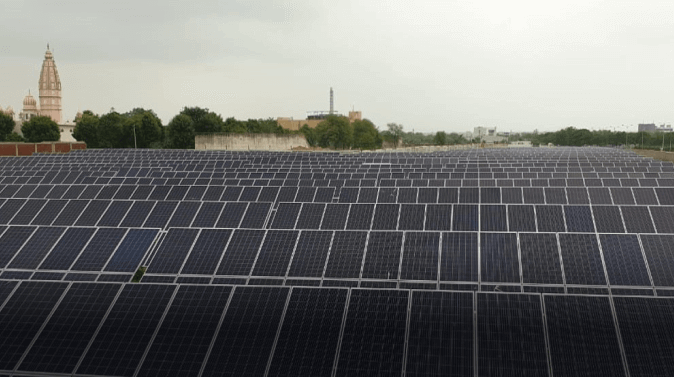
The Bank’s large offices have an Energy Performance Index of 121 signifying a 4-Star Rating as per the BEE2 benchmarking system in India.
At ICICI Bank, efficient energy management and conservation underpins our strategy of managing the Bank’s environmental footprint. The Bank’s concerted and continuous, multi-pronged efforts have led to a consistent decline in per capita energy consumption across our operations.
Our Specific Energy Consumption1 has witnessed a significant decline between fiscal 2015 and fiscal 2020. Energy Performance Index (EPI) for the large offices reduced by 21.35% and Energy Performance Metric (EPM) for branches reduced by 27.74% over the last five financial years.
Per Capita Energy Consumption

We embarked on a comprehensive energy management and conservation journey in fiscal 2013 and adopted a systematic, phased approach to managing our energy goals. Our comprehensive energy conservation strategy encompasses three broad areas – improvement in energy efficiencies, investments in design and technology and adoption of renewable energy to help us in achieving our energy goals.
Pillars of Energy Conservation Strategy
Improving efficiencies
- Capacity optimisation
- Integrated preventive maintenance
- 24°C temperature policy
- Energy audits
- Heat load calculations
- Power factor corrections
- Performance-based contracts
Investing in design and technology
- Indian Green Building Council (IGBC) defined green features in new facilities
- Energy efficient equipment
- Master switch concept
- Equipment-based monitoring and control
- Internet of Things (IoT) enabled Central Monitoring System (CMS)
Adopting renewable energy
- Promoting use of renewable energy at branches, offices and ATMs wherever feasible
- Offsite power purchase agreements
- Solar water heating system
Our energy conservation efforts gained significant momentum when we undertook a detailed energy audit in fiscal 2014. The audit covered 15 of our large offices and branches where energy consumption was higher than specific standards and identified a number of areas of saving energy.
ICICI Bank allocates a specific budget every year to continuously improve our energy efficiency. A central team uses this budget to implement initiatives to improve our energy efficiency across all offices as well as branches. Our recent initiatives in this area include:
- We ensure a 24°C temperature policy at all our offices and branches.
- We have set up control systems for optimal energy efficiency. For example, the air conditioning (AC) equipment timings are scheduled through the Building Management System to avoid power wastage. This automatically turns off air-conditioners across all our offices.
- We commissioned a direct/indirect adiabatic cooling system at the disaster recovery centre in Jaipur. This improved PUE (Power Utilisation Effectiveness) by 20%.
- We conduct regular energy audits at multiple premises for ensuring ongoing improvements in efficiency. In fiscal 2020, detailed energy audits of the ICICI Service Centre at BKC in Mumbai and the office at Gachibowli in Hyderabad were undertaken. The audit team identified measures that could lead to significant additional savings which are being implemented.
- Lithium-ion battery storage systems were deployed at two branches. This facilitated elimination of redundant equipment, enhanced reliability and improved energy efficiency by approximately 10%.
- We replaced old air-conditioning systems at 492 branches and 200 ATMs with inverter-based, 5-Star rated systems, leading to more than 25% saving in energy.
Adopting Renewable Energy
ICICI Bank ensures usage of renewable energy at its premises wherever feasible. In order to reduce our carbon footprint, in fiscal 2020, 7% of our total electricity consumption was sourced from renewable sources.
We adopt a two-pronged approach to drive the adoption of renewable energy:
As on March 31, 2020, the total solar power capacity installed at our premises was 2.8 MWp (Mega-Watt peak). We have installed small capacity solar power plants at 554 rural branches and at over 200 ATMs. In fiscal 2020, we added 1 MWp ground mount solar power plant at our Disaster Recovery Centre in Jaipur.
We have signed Power Purchase Agreements (PPA) to purchase solar and wind energy for three of our large offices under the open access mechanism for power sourcing. The total contracted capacity as on March 31, 2020 was 9 MWp. Our three large offices at Mumbai, Chennai and Hyderabad have been using renewable energy since fiscal 2016 and close to 60% of their requirements are met through it.
Renewable Energy – Capacity and Consumption
1. Specific Energy Consumption is a parameter that defines the energy consumption at buildings. This is defined by the EPI and EPM calculations. EPI = annual energy consumption at facility in kWh/area of facility in square meter. EPM = monthly energy consumption in kWh/area in square feet.
2. The Bureau of Energy Efficiency (BEE) is a statutory body set up by the Government of India. The BEE Star Rating for existing commercial buildings is a voluntary policy measure to reduce the adverse impact of corporate buildings on the environment. The Star Rating programme is based on the energy usage in the building over its area expressed in kWh/sqm/ year. It rates buildings on a scale of 1-5, with 5 being most efficient.


